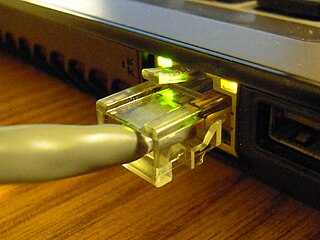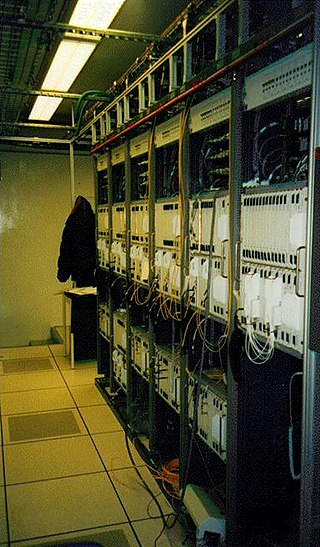
Ethernet is a family of wired computer networking technologies commonly used in local area networks (LAN), metropolitan area networks (MAN) and wide area networks (WAN). It was commercially introduced in 1980 and first standardized in 1983 as IEEE 802.3. Ethernet has since been refined to support higher bit rates, a greater number of nodes, and longer link distances, but retains much backward compatibility. Over time, Ethernet has largely replaced competing wired LAN technologies such as Token Ring, FDDI and ARCNET.

Synchronous Optical Networking (SONET) and Synchronous Digital Hierarchy (SDH) are standardized protocols that transfer multiple digital bit streams synchronously over optical fiber using lasers or highly coherent light from light-emitting diodes (LEDs). At low transmission rates data can also be transferred via an electrical interface. The method was developed to replace the plesiochronous digital hierarchy (PDH) system for transporting large amounts of telephone calls and data traffic over the same fiber without the problems of synchronization.

Network topology is the arrangement of the elements of a communication network. Network topology can be used to define or describe the arrangement of various types of telecommunication networks, including command and control radio networks, industrial fieldbusses and computer networks.
The Spanning Tree Protocol (STP) is a network protocol that builds a loop-free logical topology for Ethernet networks. The basic function of STP is to prevent bridge loops and the broadcast radiation that results from them. Spanning tree also allows a network design to include backup links providing fault tolerance if an active link fails.
Fibre Channel (FC) is a high-speed data transfer protocol providing in-order, lossless delivery of raw block data. Fibre Channel is primarily used to connect computer data storage to servers in storage area networks (SAN) in commercial data centers.

A ring network is a network topology in which each node connects to exactly two other nodes, forming a single continuous pathway for signals through each node – a ring. Data travels from node to node, with each node along the way handling every packet.
Resilient Packet Ring (RPR), as defined by IEEE standard 802.17, is a protocol designed for the transport of data traffic over optical fiber ring networks. The standard began development in November 2000 and has undergone several amendments since its initial standard was completed in June 2004. The amended standards are 802.17a through 802.17d, the last of which was adopted in May 2011. It is designed to provide the resilience found in SONET and Synchronous Digital Hierarchy networks but, instead of setting up circuit oriented connections, provides a packet based transmission, in order to increase the efficiency of Ethernet and IP services.
IEEE 802.1ag is an amendment to the IEEE 802.1Q networking standard which introduces Connectivity Fault Management (CFM). This defines protocols and practices for the operations, administration, and maintenance (OAM) of paths through 802.1 bridges and local area networks (LANs). The final version was approved by the IEEE in 2007.

A computer network is a set of computers sharing resources located on or provided by network nodes. Computers use common communication protocols over digital interconnections to communicate with each other. These interconnections are made up of telecommunication network technologies based on physically wired, optical, and wireless radio-frequency methods that may be arranged in a variety of network topologies.
Ethernet Automatic Protection Switching (EAPS) is used to create a fault tolerant topology by configuring a primary and secondary path for each VLAN.
Provider Backbone Bridge Traffic Engineering (PBB-TE) is a computer networking technology specified in IEEE 802.1Qay, an amendment to the IEEE 802.1Q standard. PBB-TE adapts Ethernet to carrier class transport networks. It is based on the layered VLAN tags and MAC-in-MAC encapsulation defined in IEEE 802.1ah, but it differs from PBB in eliminating flooding, dynamically created forwarding tables, and spanning tree protocols. Compared to PBB and its predecessors, PBB-TE behaves more predictably and its behavior can be more easily controlled by the network operator, at the expense of requiring up-front connection configuration at each bridge along a forwarding path. PBB-TE Operations, Administration, and Management (OAM) is usually based on IEEE 802.1ag. It was initially based on Nortel's Provider Backbone Transport (PBT).
A broadcast storm or broadcast radiation is the accumulation of broadcast and multicast traffic on a computer network. Extreme amounts of broadcast traffic constitute a broadcast storm. It can consume sufficient network resources so as to render the network unable to transport normal traffic. A packet that induces such a storm is occasionally nicknamed a Chernobyl packet.
A switching loop or bridge loop occurs in computer networks when there is more than one layer 2 path between two endpoints. The loop creates broadcast storms as broadcasts and multicasts are forwarded by switches out every port, the switch or switches will repeatedly rebroadcast the broadcast messages flooding the network. Since the layer-2 header does not include a time to live (TTL) field, if a frame is sent into a looped topology, it can loop forever.

Multi-link trunking (MLT) is a link aggregation technology developed at Nortel in 1999. It allows grouping several physical Ethernet links into one logical Ethernet link to provide fault-tolerance and high-speed links between routers, switches, and servers.
The Metro Ring Protocol (MRP) is a Layer 2 resilience protocol developed by Foundry Networks and currently being delivered in products manufactured by Brocade Communications Systems and Hewlett Packard. The protocol quite tightly specifies a topology in which layer 2 devices, usually at the core of a larger network, are configured and as such is able to achieve much faster failover times than other Layer 2 protocols such as Spanning Tree.
Synchronous Ethernet, also referred as SyncE, is an ITU-T standard for computer networking that facilitates the transference of clock signals over the Ethernet physical layer. This signal can then be made traceable to an external clock.
IEEE 802.1aq is an amendment to the IEEE 802.1Q networking standard which adds support for Shortest Path Bridging (SPB). This technology is intended to simplify the creation and configuration of Ethernet networks while enabling multipath routing.
High-availability Seamless Redundancy (HSR) is a network protocol for Ethernet that provides seamless failover against failure of any single network component. PRP and HSR are independent of the application-protocol and can be used by most Industrial Ethernet protocols in the IEC 61784 suite. HSR does not cover the failure of end nodes, but redundant nodes can be connected via HSR.
Link protection is designed to safeguard networks from failure. Failures in high-speed networks have always been a concern of utmost importance. A single fiber cut can lead to heavy losses of traffic and protection-switching techniques have been used as the key source to ensure survivability in networks. Survivability can be addressed in many layers in a network and protection can be performed at the physical layer, Layer 2 and Layer 3 (IP).

Media Redundancy Protocol (MRP) is a data network protocol standardized by the International Electrotechnical Commission as IEC 62439-2. It allows rings of Ethernet switches to overcome any single failure with recovery time much faster than achievable with Spanning Tree Protocol. It is suitable to most industrial Ethernet applications.





